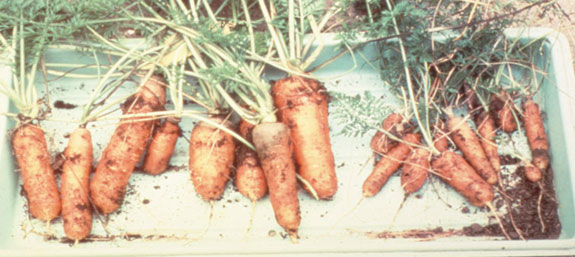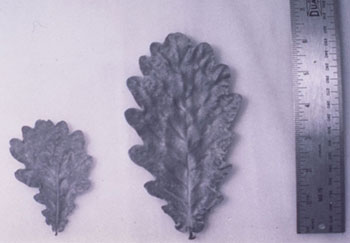Why Remineralize?

Benefits of Remineralization
- Provides slow, natural release of elements and trace minerals.
- Increases the nutrient intake of plants.
- Increases yields and gives higher brix reading.
- Rebalances soil pH.
- Increases earthworm activity and the growth of microorganisms.
- Builds humus complex.
- Prevents soil erosion.
- Increases the storage capacity of the soil.
- Increases resistance to insects, disease, frost, and drought.
- Produces more nutritious crops.
- Enhances flavor in crops.
- Decreases dependence on fertilizers, pesticides, and herbicides.
 One of many anecdotal photos sent over the years to the magazine in the early remineralization movement in the 1980s. These two oak leaves were sent by Jeannie Stevens from Victoria, Australia. The larger leaf was from an oak tree that was remineralized in March 1984. At that time the leaf was the same size as the smaller one on the left. There was a magnificent forest of seedlings under that tree in December 1986. The oak tree nearby with the smaller leaf on the left was not given an application of rock dust and had very few viable acorns and weak seedlings.
One of many anecdotal photos sent over the years to the magazine in the early remineralization movement in the 1980s. These two oak leaves were sent by Jeannie Stevens from Victoria, Australia. The larger leaf was from an oak tree that was remineralized in March 1984. At that time the leaf was the same size as the smaller one on the left. There was a magnificent forest of seedlings under that tree in December 1986. The oak tree nearby with the smaller leaf on the left was not given an application of rock dust and had very few viable acorns and weak seedlings.Soil Remineralization (SR) creates fertile soils by returning minerals to the soil in much the same way that the Earth does: during an Ice Age, glaciers crush rock onto the Earth’s soil mantle, and winds blow the dust in the form of loess all over the globe. Volcanoes erupt, spewing forth minerals from deep within the Earth, and rushing rivers form mineral-rich alluvial deposits.
Within silicate rocks is a broad spectrum of up to one hundred minerals and trace elements necessary for the well-being of all life and the creation of fertile soils. Glacial moraine or mixtures of single rock types can be applied to soils to create a sustainable and superior alternative to the use of ultimately harmful chemical fertilizers, pesticides, and herbicides.
SR has been shown in scientific studies to achieve fourfold increases in agricultural and forestry (wood volume) yields and to produce both immediate and long-term benefits from a single application.
Hundreds of thousands of tons of appropriate rock dust for soil and forest regeneration are stockpiled by the gravel and stone industry.






